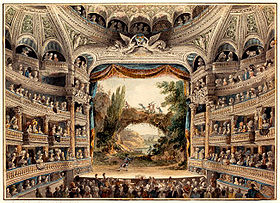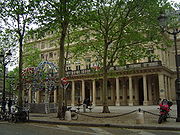
Comédie-Française
Encyclopedia


Sovereign state
A sovereign state, or simply, state, is a state with a defined territory on which it exercises internal and external sovereignty, a permanent population, a government, and the capacity to enter into relations with other sovereign states. It is also normally understood to be a state which is neither...
theaters in France
France
The French Republic , The French Republic , The French Republic , (commonly known as France , is a unitary semi-presidential republic in Western Europe with several overseas territories and islands located on other continents and in the Indian, Pacific, and Atlantic oceans. Metropolitan France...
. It is the only state theater to have its own troupe of actors. It is located in the 1st arrondissement
Ier arrondissement
The 1st arrondissement of Paris is one of the 20 arrondissements of the capital city of France.Situated principally on the right bank of the River Seine, it also includes the west end of the Île de la Cité...
of Paris
Paris
Paris is the capital and largest city in France, situated on the river Seine, in northern France, at the heart of the Île-de-France region...
.
The theatre has also been known as the Théâtre-Nautique, the théâtre de la République and La maison de Molière. It inherited the latter name (English: House of Molière) along with the dramatic venue of the best-known playwright associated with the Comédie-Française, Molière
Molière
Jean-Baptiste Poquelin, known by his stage name Molière, was a French playwright and actor who is considered to be one of the greatest masters of comedy in Western literature...
. He was considered the patron of French actors. He died seven years before “La maison de Molière” was rechristened the “Comédie-Française,” and it continued to be known popularly by the former name even after the official change of name.
History
The Comédie-Française was founded by a decree of Louis XIVLouis XIV of France
Louis XIV , known as Louis the Great or the Sun King , was a Bourbon monarch who ruled as King of France and Navarre. His reign, from 1643 to his death in 1715, began at the age of four and lasted seventy-two years, three months, and eighteen days...
on 24 August 1680 to merge the only two Parisian acting troupes of the time, the troupe of the hôtel Guénégaud and that of the hôtel de Bourgogne
Hôtel de Bourgogne
Until the 16th century, the Hôtel de Bourgogne was the name of the Paris residence of the Dukes of Burgundy. Today, the last vestige is the Tour Jean sans Peur, 20 rue Étienne Marcel, in the 2nd arrondissement.-Theatre:...
. On the death of Molière, the troupe of the hôtel Guénégaud had formed by a merger of the Théâtre du Marais and the Troupe de Molière. In 1680, the repertoire consisted of the collection of theatrical works by Molière and Jean Racine
Jean Racine
Jean Racine , baptismal name Jean-Baptiste Racine , was a French dramatist, one of the "Big Three" of 17th-century France , and one of the most important literary figures in the Western tradition...
, along with a few works by Pierre Corneille
Pierre Corneille
Pierre Corneille was a French tragedian who was one of the three great seventeenth-century French dramatists, along with Molière and Racine...
, Paul Scarron
Paul Scarron
Paul Scarron was a French poet, dramatist, and novelist. His precise birthdate is unknown, but he was baptized on July 4, 1610...
and Jean Rotrou
Jean Rotrou
Jean Rotrou was a French poet and tragedian.Rotrou was born at Dreux in Normandy. He studied at Dreux and at Paris, and, though three years younger than Pierre Corneille, began writing before him. In 1632 he became playwright to the actors of the Hôtel de Bourgogne...
. Two years after the amalgamation of the dramatic companies, they received a royal grant of 12,000 livres per year; and seven years later they took as their name their present designation of “players of the Comédie Française.”
Its first building was housed at the Hôtel de Guénégaud
Hôtel de Guénégaud
-3rd arrondissement:At 60, rue des Archives, this Hôtel de Guénégaud was built between 1651 and 1655 for Jean-François de Guénégaud des Brosses, secrétaire du Roi, maître des Comptes and conseiller d'État, by François Mansart . It now houses the Musée de la Chasse et de la Nature and the Club de la...
.
The Hôtel de Guénégaud Theatre was Molière's dramatic institution, and had originally been an old theatre where miracle plays had been presented as early as 1543. Thus the Comédie-Française may be said to have an unbroken tradition reaching back to the days of Molière, and to have had theatre connections for more than a century previous to the death of the great dramatist in 1673.
On the performance of Joseph Chénier
Joseph Chénier
Marie-Joseph Blaise de Chénier was a French poet, dramatist and politician.The younger brother of André Chénier, he was born at Constantinople, but brought up at Carcassonne. He was educated in Paris at the Collège de Navarre...
's anti-monarchical play Charles IX in 1789, violent political discussions arose among the performers, and ultimately they split into two sections: the Republican party, under the young tragedian Talma, establishing a new theatre under the name “Théâtre de la République,” on the site of the present building in the Rue de Richelieu; while the Royalist section took the title “Théâtre de la Nation.” On 3 September 1793, during the French Revolution
French Revolution
The French Revolution , sometimes distinguished as the 'Great French Revolution' , was a period of radical social and political upheaval in France and Europe. The absolute monarchy that had ruled France for centuries collapsed in three years...
, the Théâtre de la Nation was closed by order of the Committee of Public Safety
Committee of Public Safety
The Committee of Public Safety , created in April 1793 by the National Convention and then restructured in July 1793, formed the de facto executive government in France during the Reign of Terror , a stage of the French Revolution...
for putting on the allegedly seditious play Pamela, and the actors were imprisoned though gradually released later. On 31 May 1799, the new government made the salle Richelieu available and allowed the actors to reconstitute the troupe.
The Comédie-Française today has a repertoire of 3,000 works and three theaters
Theater (structure)
A theater or theatre is a structure where theatrical works or plays are performed or other performances such as musical concerts may be produced. While a theater is not required for performance , a theater serves to define the performance and audience spaces...
in Paris
Paris
Paris is the capital and largest city in France, situated on the river Seine, in northern France, at the heart of the Île-de-France region...
(salle Richelieu, next to the Palais Royal
Palais Royal
The Palais-Royal, originally called the Palais-Cardinal, is a palace and an associated garden located in the 1st arrondissement of Paris...
; théâtre du Vieux-Colombier
Théâtre du Vieux-Colombier
The Théâtre du Vieux-Colombier is a theatre located at 21, rue du Vieux-Colombier, in the 6th arrondissement in Paris. It was founded in 1913 by the theatre producer and playwright Jacques Copeau...
; Studio-Théâtre).
Theater buildings
The Comédie-Française has had several homes since its inception. In 1689, it was established across from the café ProcopeCafé Procope
Café Procope, in rue de l'Ancienne Comédie, 6th arrondissement, is called the oldest restaurant of Paris in continuous operation. It was opened in 1694 by the Sicilian Francesco Procopio dei Coltelli, with a slyly subversive name adopted from the historian Procopius, whose Secret History, the...
. The Odéon
Odéon
The Odéon-Théâtre de l'Europe is one of France's six national theatres.It is located at 2 rue Corneille in the 6th arrondissement of Paris on the left bank of the Seine, next to the Luxembourg Garden...
was designed by architects Marie-Joseph Peyre
Marie-Joseph Peyre
Marie-Joseph Peyre was a French architect who designed in the neoclassical style.- Biography :He began his training in Paris with Jacques-François Blondel at l'École des Arts, where he met Giovanni Niccolo Servandoni and formed a life-long friendship with Charles De Wailly...
(1770–1843) and Charles De Wailly
Charles De Wailly
Charles De Wailly was a French architect and urbanist, and furniture designer, one of the principals in the Neoclassical revival of the Antique. His major work was the Théâtre de l'Odéon for the Comédie-Française...
(1730–1798). From 1770 to 1782, the Comédie had quarters in the royal palace of the Tuileries. Since 1799, the Comédie-Française has been housed in the salle Richelieu (architect Victor Louis
Victor Louis
Victor Louis was a French architect, winner of the Prix de Rome in 1755.Louis was responsible for the Grand Théâtre de Bordeaux of 1780 and the galleries of the Palais-Royal in Paris. A full biography was published in Bordeaux in 1881. In 1770 he married the pianist and composer .-References:...
) at 2, rue de Richelieu
Rue de Richelieu
Rue de Richelieu is a long street of Paris, starting in the south of the Ier arrondissement, ending in the IIe arrondissement. For the first half of the nineteenth century, before Baron Hausmann redefined Paris with grand boulevards, it was one of the most fashionable streets of Paris:The Rue de...
. This theater was enlarged and modified in the 1800s, then rebuilt in 1900 after a severe fire.
Theatrical troupe
The membership of the theatrical troupe is divided into “sociétaires” and “pensionnaires.” The former are regular members of the organization and as such receive a pension after 20 years of service, while the latter are paid actors who may, after a certain length of service, become “sociétaires.” The names of nearly all the great actors and dramatists of France have, at some time in their career, been associated with that of the Comédie-Française.Administrators of the Comédie-Française

The chief administrator of the Comédie-Française has been given the title administrateur général since Simonis' term of 1850. Before that, a variety of titles were given.

